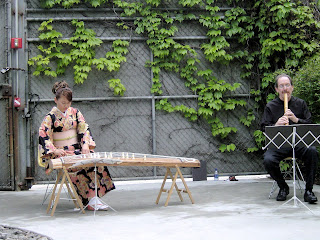
It was the perfect setting: the peaceful museum dedicated to the works of the Japanese sculptor Isamu Noguchi. The only problem was that there was thunder in the air on this pressingly warm spring Sunday afternoon. There was a drizzle, which forced the organizers to move the concert inside. We were sitting on the concrete floor between Noguchi’s symbolic sculptures. Behind the performers two large windows gave to the garden where the leaves in the trees were still the light green colour of spring. We were set for a performance by two premier talents of Japanese music.
Ralph Samuelson came on stage with his shakuhachi. Samuelson who has studied the ancient bamboo flute both in Japan and in the United States under such masters as Goro Yamaguchi, Kodo Araki V and Shudo Yamato, adheres to the classical tradition of the Kinko school. His playing is exquisite in its sensitivity, the voice of his flute clear and lovely. He started the concert with a traditional piece, Kumoi Jishi, which has a charming folk music like melody.
Next Masayo Ishigure appeared and sat down behind the koto, the 13-string Japanese zither of which she is a master. Ishigure-san hails from Gifu in Japan and has won numerous accolades for her skill as a koto player. Since she moved to New York in 1992, she has performed in prestigious venues, like Lincoln Center and the Carnegie Hall. She teaches Japanese music at Wesleyan University. She had chosen to start her part of the concert with a contemporary composition, Tokimeki, by Hideaki Kuribayashi. Seldom have I heard such a variety of tonalities and rhythms played on a koto. Masayo Ishigure is a very versatile musician.
Having observed the weather during his colleague’s performance, Ralph Samuelson declared that the clouds had cleared and the sun was fast drying up the garden. It was thus time to move outside where the performance area in front of the old factory gate was quickly set up. The Noguchi Museum (www.noguchi.org) is an amazing haven in the middle of a working class industrial neighbourhood in Long Island City in the Borough of Queens. The museum itself has been established in an old factory building. From the street in front of it, Manhattan skyline is clearly visible across East River.
Ralph announced that here was a perfect natural acoustic, with trucks, airplanes, children – and the distant cry of the deer. For that was what the next tune was about. Shika no Tone, a piece belonging to Honkyoku or solo shakuhachi repertoire developed by Fuke sect Zen monks in the 18th century, represents the sound of two deer calling each other in the distant mountains. This quiet, meditative piece indeed drowned the urban sounds from the surrounding barrio as we sat on the ground basking in the afternoon sun.
Masayo Ishigure returned, her spring kimono with its depictions of white and pink cherry blossoms against black silk immaculate. Her second piece also was contemporary koto music, a famous 1985 piece of Tadao Sawai’s called Tori no Yo Ni. Sawai had once been her teacher in Japan and she played the beautiful and rather complex piece with extraordinary verve, evoking images of birds flying freely in the big, open sky. This, as the previous piece she had played inside, took the traditional stringed instrument to exceptional distances, blending varied influences into the Japanese sensibility.
Finally, the two masters joined together in the last piece, Yoshizawa Kengryo II’s 19th century Chidori no Kyoko or Song of Plovers. This piece, like so much of Japan’s music and art, too, was nature inspired. The piece featured two waka poems sung by Masayo Ishigure in a sorrowful ceremonial style. Her hypnotic voice and use of micro-tones was like that of monks chanting. The poems – the first from the 10th century Kokin waka shu anthology of court poetry; the second from a 12th century anthology Kin ‘yo shu – both were about the song of the plovers. The two songs were separated by a serene instrumental interlude, or tegoto, which Ishigure and Samuelson played with exquisite grace.
The music had calmed the afternoon and, I am sure, added years to our lives. All stress and bad thoughts were gone, as we sat in the sculpture garden under the white birches with their leaves fluttering in the wind.
© Juha I. Uitto 2005
No comments:
Post a Comment